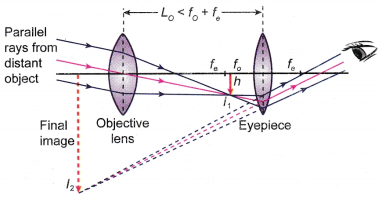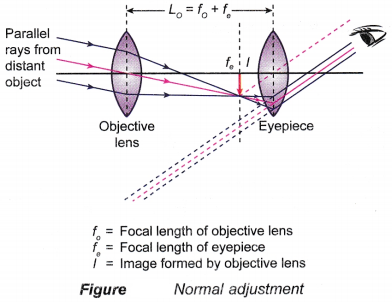To Construct Optical Devices Using Lenses
To Construct a Compound Microscope
- The materials required for the construction of a compound microscope:
(a) A convex lens with a power of +20 D (f0 = 5.0 cm) and a large diameter is used as the objective lens.
(b) A convex lens with a power of +14.3 D (fe = 7.0 cm) and a small diameter is used as the eyepiece.
(c) A cardboard tube with a diameter similar to the objective lens and a cardboard tube with a diameter similar to the eyepiece.
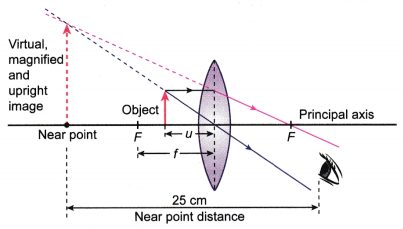
- A small sheet of graph paper (as object) is placed in front of the objective lens. The distance of the graph paper is adjusted to slightly greater than 5 cm (2f > u > f). A lamp is directed at the graph paper.
- The translucent screen is adjusted until a real, inverted and magnified image is formed.
- The distance of the eyepiece is slowly adjusted until a clear and very large image (a few times larger) is seen through the eyepiece.
- The translucent screen is then removed. The set-up of the lenses can function as a compound microscope.
- The distance between the objective lens and the eyepiece is measured. This distance is greater than the sum of the focal lengths of the objective lens and the eyepiece:
L0 > f0+ fe (5 cm + 7 cm) - The objective lens and the eyepiece are then fitted into the tubes as shown in Figure.
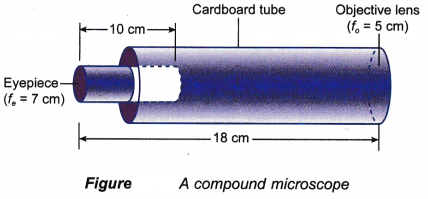
- This is a simple compound microscope constructed by using two high power convex lenses.
People also ask
- What is a Lens?
- What is the thin lens equation?
- Lens Formula & Magnification – Lens Power
- What are the Types of Spherical Lenses
- Image Formation By Concave And Convex Lenses
- The Uses of Lenses in Optical Devices
To Construct an Astronomical Telescope
- The materials required for the construction of an astronomical telescope:
(a) A convex lens with a power of +2 D (f0 = 50.0 cm) and a large diameter is used as the objective lens.
(b) A convex lens with a power of +10 D (fe = 10.0 cm) and small diameter is used as the eyepiece.
(c) A cardboard tube with a diameter similar to the objective lens and a cardboard tube with a diameter similar to the eyepiece. - The objective lens and the eyepiece are arranged as shown in Figure.

- The objective lens is then directed to a distant object. A translucent screen is placed about 50 cm from the objective lens and is adjusted until a sharp image is seen on the screen.
- The eyepiece that is placed in front of the translucent screen is adjusted until a clear and magnified image is seen through the eyepiece.
- The translucent screen is removed and the set¬up of the lenses can function as an astronomical telescope.
- The distance between the two lenses is measured. This distance is less than or equal to the sum of the focal lengths of the two lenses:
L0 ≤ f0+ fe (50 cm + 10 cm) - The objective lens and the eyepiece are then fitted into the tubes as shown in Figure.
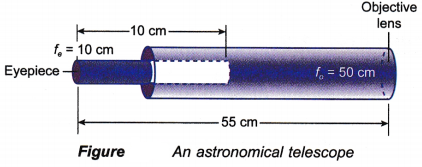
- This is a simple astronomical telescope constructed by using a low power lens and a high power lens.
Example: Figure shows the arrangement of an optical system in a slide projector. The slide, XY is put upside down.
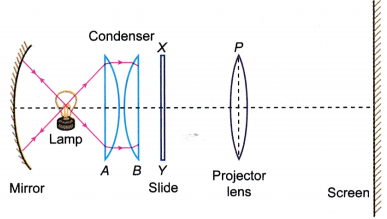
(a) Why does the slide have to be put upside down into the slide projector?
(b) The lamp is placed at the focal point of lens A and at the centre of curvature of the concave mirror. Why?
(c) Complete the ray diagram from lens B onwards, to show how the projector lens forms an image of the slide on the screen.
(d) If the slide is placed 5 cm from lens P, the screen has to be placed 4 m from the lens to form a sharp image. What is the focal length of lens P?
(e) The screen is now moved to a new position. It is found that lens P has to be adjusted further away from the slide in order to give a sharp image on the screen.
(i) Has the screen been moved nearer to or further away from the projector?
(ii) What change, in brightness and size, has occurred to the image?
(f) What would happen if the distance between lens P and the slide is reduced to its focal length?
Solution:
(a) Real images that can be projected on the screen are always inverted. Therefore, the slide has to be upside down so that the image will be seen upright.
(b) The lamp is placed at the centre of curvature of the concave mirror so that all light rays behind the lamp are reflected back along the same path to the condenser. The lamp is placed at the focal point of lens A so that all light rays passing through it become parallel and spread evenly on the whole slide after passing through lens B.
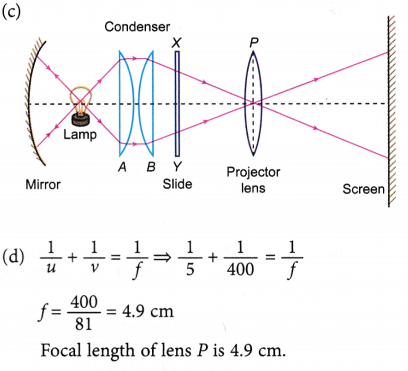
(e) (i) The screen has been moved nearer to the projector.
(ii) The image is brighter and smaller.
(f) No image is formed on the screen.


 and the magnification produced by the eyepiece is:
and the magnification produced by the eyepiece is:

